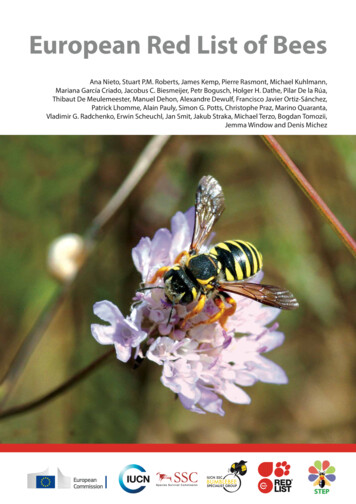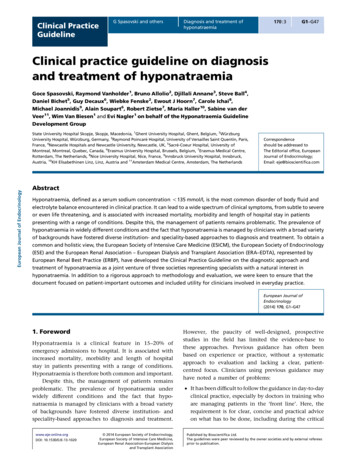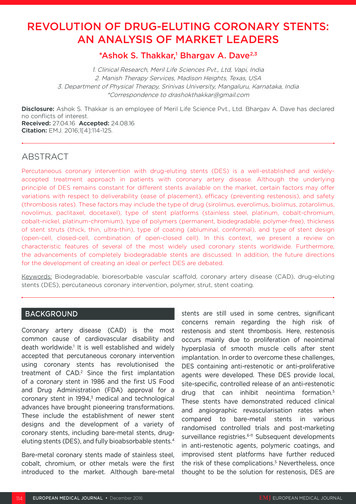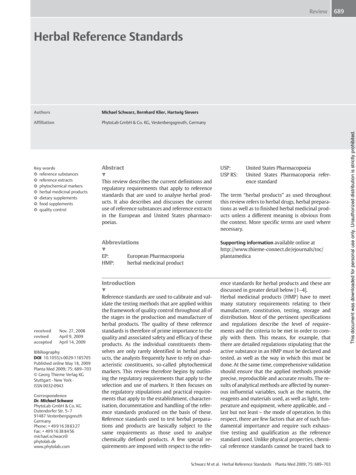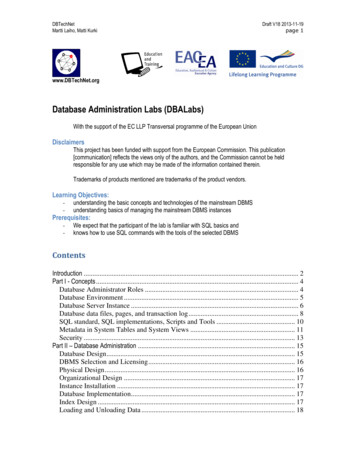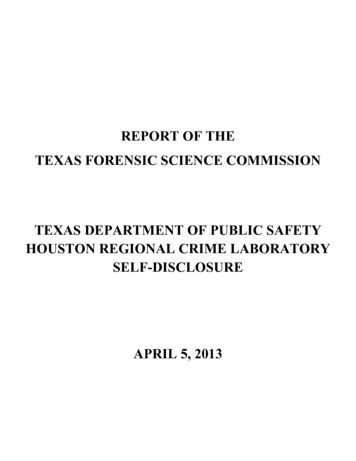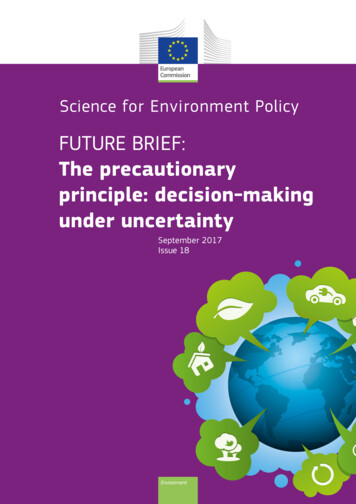
Transcription
Science for Environment PolicyFUTURE BRIEF:The precautionaryprinciple: decision-makingunder uncertaintySeptember 2017Issue 18Environment
2T H EP R E C A U T I O N A R YP R I N C I P L E :D E C I S I O N - M A K I N GU N D E RU N C E R T A I N T YThis Future Brief is written and edited by the ScienceCommunication Unit, University of the West of England(UWE), BristolEmail: sfep.editorial@uwe.ac.ukScience for Environment PolicyThe precautionary principle: decision-making underuncertaintyContentsIntroduction31. Scientific uncertainty52. Criticisms and responsesCase study: Scientific uncertainty and climatechange litigation683. Precautionary principle in practice: applicationin the EU3.1 Scope for a more precautionary approach?Case Study: How the UK Government has usedthe precautionary principle3.2 Contexts of application3.3 Using the precautionary principle to manageenvironmental risks from technologies in the EUCase Study: The precautionary principle inbiodiversity management — Capercaillies inthe Black Forest94. Conclusion20References22To cite this publication:Science for Environment Policy (2017) The Precautionary Priniple:decision making under uncertainty. Future Brief 18. Produced forthe European Commission DG Environment by the ScienceCommunication Unit, UWE, Bristol. Available cknowledgementsWe wish to thank the scientific adviser Professor Elen Stokes(Birmingham Law School) for her input to this report. Finalresponsibility for the content and accuracy of the report,however, lies solely with the author.911141619Figures and TablesPage 13: TABLE 1: Interpreting the strength of application of the precautionary principle.Source: Garnett & Parsons, 2017.Page 15: FIGURE 1: An enabling principle: UK ILGRA’s approach to establishing crediblescenarios. Adapted from The Precautionary Principle: Policy and Application. The need fora consistent approach. UK-ILGRA, 2002.Page 17: FIGURE 2: An illustrative general framework for using the precautionaryprinciple. Adapted from Stirling, 2016–14.ImagesReproduced with permission by the relevant author or publisher, or otherwise publiclyauthorised for use.About Science for Environment PolicyScience for Environment Policy is a free newsand information service published by the EuropeanCommission’s Directorate-General Environment,which provides the latest environmental policyrelevant research findings.Future Briefs are a feature of the service,introduced in 2011, which provide expert forecastsof environmental policy issues on the horizon. Inaddition to Future Briefs, Science for EnvironmentPolicy also publishes a weekly News Alert whichis delivered by email to subscribers and providesaccessible summaries of key scientific licyKeep up-to-dateISBN 978-92-79-67015-2ISSN 2363-278XDOI 10.2779/709033The contents and views included in Science for EnvironmentPolicy are based on independent research and do not necessarilyreflect the position of the European Commission. European Union 2017Subscribe to Science for Environment Policy’sweekly News Alert by emailing:sfep@uwe.ac.ukOr sign up online at:http://ec.europa.eu/science-environment-policy
T H EP R E C A U T I O N A R YP R I N C I P L E :D E C I S I O N - M A K I N GU N D E RU N C E R T A I N T Y3IntroductionThe precautionary principle: itsrole in law and policyOne of the greatest challenges facing today’s environmental policymakers is how to deal withcomplex risks, such as those associated with climate change. These risks are difficult to deal withbecause they are not precisely calculable in advance. Where there is scientific uncertainty aboutthe full extent of possible harms but ‘doing nothing’ is also risky, decision-makers may use theprecautionary principle. This Future Brief explores the role of the precautionary principle in EU lawand policy, and examines key points of discussion drawn from the evidence.Inattendu situation iStock/Bplanet 2015Incomplete information, inconclusive evidenceand public controversy can make it difficult toachieve consensus over the appropriate responseto hazardous substances or activities, but these areprecisely the sorts of conditions that often demandhard and fast decisions.The precautionary principle is designed to assistwith decision-making under uncertainty and is acore principle of EU environmental law, enshrinedin Article 191(2) of the Treaty on the Functioningof the EU. The classic definition of ‘a precautionaryapproach’ comes from the 1992 Rio Declaration onEnvironment and Development, which states that:‘"Where there are threats of serious or irreversibledamage, lack of full scientific certainty shall not beused as a reason for postponing cost-effective measures toprevent environmental degradation" (UNEP 1992).
4T H EP R E C A U T I O N A R YP R I N C I P L E :In other words, a precautionary approach capturesthe idea that regulatory intervention may still belegitimate, even if the supporting evidence isincomplete or speculative and the economic costsof regulation are high. Better safe than sorry. Inthe Communication on the Precautionary Principle from20001, the European Commission clarified that:"Recourse to the precautionary principle presupposesthat potentially dangerous effects deriving from aphenomenon, product or process have been identified,and that scientific evaluation does not allow the risk tobe determined with sufficient certainty.The implementation of an approach based on theprecautionary principle should start with a scientificevaluation, as complete as possible, and where possible,identifying at each stage the degree of scientificuncertainty" (European Commission, 2000, COM(2000) 1 final).The European Commission also refers to theneed for ‘reasonable grounds for concern’ aboutpotential risks. Crucially, this means that theprinciple ought only to be used if a risk is deemed tobe plausible. Any regulatory measures introducedas a result of the precautionary principle shouldalso be subject to review in light of new scientificdata, and may have to be modified or abolished asnew scientific data become available.In this sense, the Communication provides a stepby-step guide to applying the principle; however,it is not prescriptive and is designed to be flexible,D E C I S I O N - M A K I N GU N D E RU N C E R T A I N T Yallowing for the variety of circumstances in whichthe principle might operate. The Commissionnotes that it is ultimately for decision-makers andthe courts to flesh out the details.The Communication is just one account of theprecautionary principle; others can be found indifferent legal contexts. Even within EU law, theprecautionary principle is highly malleable andperforms many different functions (Scotford, 2017).As a result, the precautionary principle is seen asmore complex and dynamic than the principle ofprevention, which addresses better-understood risksto the environment. In reality, it is difficult to drawa sharp line between ‘precaution’ and ‘prevention’,given that science always entails elements of doubtand uncertainty. One notable difference, however,is that the principle of prevention has not generatedthe same level of controversy as the precautionaryprinciple — possibly because the idea of acting onknown risks is less objectionable, given the EU’semphasis on ‘evidence-based policy’.The precautionary principle has been appliedto a diverse range of fields, including healthprotection, environmental regulation, biodiversitymanagement and emerging technologies. It maybe difficult to reach agreement on exactly how toimplement the precautionary principle, becauseunderstandings of risk can vary among decisionmakers, stakeholders and citizens. No doubt theprecautionary principle will continue to sparkdebate about the best ways of dealing withenvironmental change.Risk management concept iStock/Cacaroot 20161. http://eur-lex.europa.eu/legal-content/EN/TXT/?uri LEGISSUM:l32042
T H E1.P R E C A U T I O N A R YP R I N C I P L E :D E C I S I O N - M A K I N GU N C E R T A I N T Y5Scientific uncertaintyScientific uncertainty is key to understanding howand why the precautionary principle applies (vonSchomberg, 2012).The development of ‘evidence-based policy’has highlighted the challenges of dealing withenvironmental uncertainty (Stirling, 2016). It isunrealistic to expect regulatory science to providetotally conclusive information to governments onpublic health or environmental issues — as someelement of uncertainty is an unavoidable part ofscientific inquiry. It can be difficult to determineexactly when and how to act on potential risks(Uggla et al., 2012). Definitive answers to suchquestions are not available: principles like theprecautionary principle are not rules that prescribespecific actions or outcomes.The meaning of ‘uncertainty’ is also more complexthan might be apparent. Science and technologystudies have shown that uncertainty can stem frommore than a simple lack of data or inadequatemodels of risk assessment. Uncertainty mightalso exist in the form of indeterminacy (where wedon’t know all the factors influencing the causalchains), ambiguity (where there are contradictorycertainties), and ignorance (where we don’t knowwhat we don’t know). The precautionary principlecan play an important role in addressing thesemultiple layers of uncertainty.To illustrate whether and how the precautionaryprinciple might apply to different types ofuncertainty, Von Schomberg (2012) considersfour scenarios: U N D E RThe precautionary principle is not intended toapply to ‘hypothetical effects and imaginaryrisk’; rather, it should be based on a scientificexamination of the issue. Indeed, this hasbeen confirmed on numerous occasions bythe Court of Justice of the EU (see e.g. CaseT-13/99 Pfizer Animal Health SA v Councilof the European Union [2002] ECR II-03305). The precautionary principle will not applywhere the desired level of protection is definedand the risk of harm can be quantified. Thissituation can be dealt with using ‘normal’ riskmanagement tools. Where an activity or substance poses a plausiblethreat of harm but there is insufficient scientificevidence, or a lack of agreement as to thenature or scale of the likely adverse effects, aprecautionary approach can be justified. A precautionary approach might be warrantedwhere the potential harms are known but theparticular cause-effect relationships cannot bescientifically established.As is clear, there is no single approach to theprecautionary principle. Persson (2016) suggests that‘extra precaution’ may be justified when dealing withimportant values (such as health and environmentalprotection), although these are systematicallydownplayed by more traditional decision methods;or when we suspect that the decision might lead toirreversible and severe consequences, and where thevalues at stake are also irreplaceable; or when it ismore important to avoid false negatives than falsepositives. Understandings of the precautionaryprinciple will continue to develop as conceptionsof uncertainty evolve.
62.T H EP R E C A U T I O N A R YP R I N C I P L E :D E C I S I O N - M A K I N GU N D E RU N C E R T A I N T YCriticisms and responsesA common criticism of the precautionaryprinciple is that it is ill-defined. Concerns relateto ambiguous terms such as ‘irreversible harm’or ‘lack of full scientific certainty’. For example,Sandin (2006) criticises the Rio Declaration’sformulation for only telling us what not to do, andfor not defining a ‘serious threat’.Critics have suggested that these definitionalproblems undermine legal certainty (Morris,2000) and produce inconsistent and unprincipleddecisions (Marchant & Mossman, 2004). Someargue that particular versions of the principle areparalysing because they offer no guidance andforbid all courses of action (Sunstein, 2003).Responses to criticisms of ambiguity includethe argument that inconsistency is not caused bythe principle itself, but rather by its application.Garnett & Parsons (2016) review a selectionof EU cases which invoke the principle andsuggest that the decision on whether to apply theprecautionary principle in EU law can be unclear,‘with ambiguities inherent in determining whatlevel of uncertainty and significance of hazardjustifies invoking the precautionary principle’(Garnett & Parsons, 2017).conditions of uncertainty (Grant & Quiggin,2013).A further criticism of the precautionary principleis that it is anti-scientific and stifles innovation.This argument is most commonly directed at‘strong’ interpretations of the principle — whichmay be understood as ruling out all developmentsthat could have adverse health or environmentalconsequences.This interpretation of the principle is attackedon the basis that it is never possible to eliminaterisk altogether; there is no such thing as a zerorisk activity. An associated fear is that overlyprecautionary decision-making will discourageinvestment in technological development, leading‘in no direction at all’ (Sunstein, 2003). Theprinciple is also sometimes misunderstood bycritics to mean ‘excessive’ regulation rather thanprecaution. Some of these concerns are voicedby industry representatives fearing burdensomerules because of the precautionary principle.However, others argue that applying the principledoes not necessarily mean more stringent or costlyregulation, and that it could simply be used toIt has also been pointed out that conventionalrisk assessment is no more ‘intrinsically immune’to manipulation than other decision principles(Stirling, 2016). The precautionary principle shouldnot be understood as a precise formula but rathera ‘flexible principle that ensures that decisionmakers are not ignoring problems of scientificuncertainty’ (Fisher, 2007).Stirling (2016) emphasises that the precautionaryprinciple can be used in multiple ways, inconjunction with various risk-assessment andforesight tools (Science for Environment Policy,2016). The principle can be read as a simplerequirement to take risks into account, even ifthey are unproven, which is an approach commonto all mainstream fields of decision-making inFunny cartoon scientist with a question mark iStock/artenot2013.
T H EP R E C A U T I O N A R YP R I N C I P L E :D E C I S I O N - M A K I N GU N D E RU N C E R T A I N T Y7Wind power, development of. Pixabay/winniero 2016. Creative commons CC0ensure better processes of decision-making ratherthan any particular outcome.The Wingspread Conference Statement on thePrecautionary Principle (issued following ameeting between scientists, philosophers, lawyersand environmental activists in Wisconsin, UnitedStates, in 1998) states that the application ofthe principle should involve ‘open, informedand democratic’ processes, and ‘must includepotentially affected parties’.It does not follow that precaution is un- or antiscientific. What is unscientific, says Stirling (2016),is to ignore multiple perspectives on uncertainty.The fact that the precautionary principle canencourage more open discussion of the valuejudgements underpinning methods of riskassessment and cost-benefit analysis can be saidto make the principle more, rather than less,reasonable and accountable. The precautionaryprinciple may also help to avoid situations in whichstandard risk analysis otherwise creates a bias infavour of taking chances on poorly understoodrisks (Grant & Quiggin, 2013).One response to arguments that the precautionaryprinciple is too strong (and thus paralysing) or tooweak (and thus meaningless) is that the principlemay be used for a range of different purposes(such as strengthened standards, monitoringmeasures or licensing arrangements).Braunisch et al. (2015) develop a ‘gradated’approach to precaution, which goes beyond binaryarguments (‘anti-scientific’/‘pro-scientific’, ‘antiinnovation/‘pro-innovation’). Their case study onwind-power developments (see page 19) highlightsthe potential for a more nuanced application ofthe precautionary principle.
8T H EP R E C A U T I O N A R YP R I N C I P L E :D E C I S I O N - M A K I N GU N D E RU N C E R T A I N T YCase Study: Scientific uncertainty and climate change litigationA recent legal analysis suggests that using theprecautionary principle in climate-change-relatedlegal cases could increase the chances of successby overcoming problems of scientific uncertaintythat are otherwise exploited by defendants(Omuko, 2016).Frustrations over failure to tackle climate changehas driven some public-interest groups, individualsand local governments to take corporations andnational governments to court, particularly inAustralia and the United States. In a recent examplein Europe, a case was brought against the Dutchgovernment by a Dutch NGO (Hague Districtcourt, 2015). In this landmark case, the court ruledthat the government was neglecting its duties toaddress climate change adequately and ordered itto curb the Netherlands’ emissions. However, thisexample is an exception to the general pattern.Elsewhere, most climate-change-related casesdo not lead to successful rulings. Omuko (2016)argues that the main barrier to success is the ‘proofproblem’. This refers to two related issues: The first issue is the ‘drop in the ocean’problem. This is an argument often used bydefendants to claim that their emissions aretoo small compared with global emissions tocause any real impact.The second issue is scientific uncertainty.Although there is strong scientific evidence ofclimate change and its impacts, it is not possibleto link a specific impact to a specific source ofemissions — as is usually required by courts.The precautionary principle may be used inthese situations to take protective measuresnotwithstanding a lack of evidence of harm orstraightforward causal relationships. In practice,it may allow courts to accept general evidenceof climate change and its impacts. For instance,evidence of global sea-level rise could meanthat erosion at a specific coastal site is likely.This approach was taken in an Australian case,where the court accepted the general consensusthat climate change will lead to a risk of extremeweather events, and, therefore, did not grant abuilding permit to construct seaside apartments.2The precautionary principle could also shift theburden of proof to the defendant. This occurredin the United States where the EnvironmentalProtection Agency (EPA) was required to provethat greenhouse gas emissions from the transportindustry do not contribute to climate change.The EPA failed to prove this and was ordered toregulate transport emissions. The court took aprecautionary approach in this case, arguing thatthe EPA could not avoid its obligations becauseof some ‘residual uncertainty’ (Supreme Court ofthe United States, 2007).Omuko (2016) argues that increased use of theprecautionary principle in litigation could lead tomore successful judgements and, consequently,place greater pressure on governments andbusinesses to be more proactive in their responseto climate change.2. Gippsland Coastal Board vs South Gippslands & Others: sources/gippslandcoastal board v south gippsland sc and others.pdf
T H E3.P R E C A U T I O N A R YP R I N C I P L E :D E C I S I O N - M A K I N GU N C E R T A I N T Y9Precautionary principle in practice: application in the EUThe precautionary principle was formally adoptedin the Maastricht Treaty in 1992, and is one ofthe main principles on which EU environmentalpolicy is based. Article 191(2) Treaty on theFunctioning of the EU3 imposes an obligation onEU institutions to ensure that EU environmentalpolicy is based on the precautionary principle.The principle has also been incorporated into anumber of measures of secondary legislation(i.e. Regulations and Directives), which applyto Member States. For example, the principleunderpins the 2007 Regulation on the Registration,Evaluation, Authorisation and Restriction ofChemicals (REACH)4, which gives greaterresponsibility to industry to manage the risksfrom chemicals and to provide safety informationon substances circulating in the EU market.The European Commission’s Communication onthe Precautionary Principle provides additionalinformation about the procedural steps thatdecision-makers are expected to take inimplementing the precautionary principle.The Communication states that an approachbased on the precautionary principle should: start with the fullest possible scientificevaluation, identifying at each stage and as faras possible the degree of scientific uncertainty; entail an evaluation of various riskmanagement options, including the option oftaking no precautionary action; and U N D E Rinvolve as early as possible and, to the extentreasonably possible, all interested parties.The Communication goes on to explain that anymeasures adopted on the basis of the precautionaryprinciple should also be: proportionate (i.e. should not go beyond whatis appropriate); non-discriminatory and consistent (meaningthat comparable situations should not betreated differently); based on cost-benefit analysis; and subject to review when new scientificinformation becomes available.3.1 Scope for a more precautionaryapproach?Some case studies, e.g. Harremoës et al. 2002, havesuggested that, had the precautionary principlebeen applied in certain situations, for exampleto limit the use of specific habitat-damagingantifouling agents in paints for ships and boats,environmental harm could have been avoided(Santillo et al. 2001).Patterson & Gray (2012) identify the UKGovernment’s initial failure to adopt aprecautionary approach to bovine spongiformencephalopathy (BSE) in British cattle, arguingthat it was a major policy mistake to interpret ‘noevidence of harm’ as ‘evidence of no harm’.Historical case studies have led some to concludethat a more precautionary response was neededto manage human exposure to substances suchas asbestos and dichlorodiphenyltrichloroethane(DDT) (Harremoës et al. 2002).3. e-191.html4. ach en.htm
10T H EP R E C A U T I O N A R YP R I N C I P L E :D E C I S I O N - M A K I N GU N D E RU N C E R T A I N T YBusiness accident iStock/Bplanet 2014.In a more recent example, the Organisationfor Economic Co-operation and Development(OECD) has called for a precautionary approachto particular applications of nanotechnology,stating that "there is enough evidence to suggestthat exposure to nanoparticles, particularly tothose insoluble in water, should be minimised as aprecaution."(OECD, 2005).The precautionary principle is said to apply tothe EU regulation of nanotechnologies becauseexisting EU legislation, such as REACH, is alreadyunderpinned by the principle. REACH andchemical classification, labelling and packaging(CLP) are currently used as frameworks for therisk management of nanomaterials when theyoccur as substances or in mixtures.However, as the framework in these areas hasbeen established without specifying whethersubstances are nano- or non-nano-scale, thereis an uncertainty as to whether relevant riskassessment, also leading to identification ofadequate risk management, can be generallyanticipated as the result of this framework. ‘Inorder to close those gaps, it is necessary to turnto the precautionary principle and argue for aninterpretation of the relevant provisions in thelight thereof.’ (Heselhaus, 2010).While the European Commission states thatcurrent regulatory regimes reflect the precautionaryprinciple, it notes that "additional precautionaryaction such as substance or use restrictions forindividual substances (including on particularforms or modifications of nanomaterials) maybecome necessary if new information becomesavailable indicating serious potential risks"(European Commission, 2012).
T H EP R E C A U T I O N A R YP R I N C I P L E :D E C I S I O N - M A K I N GU N D E RU N C E R T A I N T Y11Case Study: How the UK Government has used the precautionaryprincipleIn line with the EU principles, the UKGovernment implemented a precautionaryapproach to its decision-making and, as earlyas 1990, acknowledged it as a key principle ofenvironmental policy. However, the UK hascome under criticism from certain researchersand commentators for only implementing theprecautionary principle as a last resort or whenstrongly influenced by public opinion or the EU(Boehmer-Christiansen, 1994).Committee on Toxicity of Chemicals in Food,Consumer Products and the Environment) hadadvised the government that there were no provenhealth risks from low exposure to OPs. Patterson& Gray (2016) suggest that the government tookthe view that banning OPs could lead to the useof other substances that could harm water qualitywithin rivers. The government was criticised for itsapproach and it has been suggested that its decisionmay have been influenced by industry pressure.Patterson & Gray (2016) have assessed whetherthe UK government uses the precautionaryprinciple in an opportunistic or pragmaticmanner in environmental decision-making. Casestudies were used to examine the government’sposition, including their approach to the use oforganophosphorous pesticides (OPs) in sheepdips and genetically-modified (GM) crops.When legislating on GM crops, the UK governmentstarted from a similar position. The governmentinitially saw GM crops as a potential new market,as no hazards had been shown by early research.The government’s position changed due to publicopposition and EU policy (the EU having adopteda stronger precautionary approach).Official and non-official documents were consultedto assess the cases, including Parliamentary SelectCommittee reports, government departmentalreports, scientific research reports and journalarticles, and newspaper reports. In addition, 14interviews were conducted with Members ofParliament, members of advisory committees,research scientists, and members of advocacygroups such as the OrganophosphorusInformation Network (OPIN).OPs were commonly used in sheep dips to controlskin parasites, such as lice and sheep scab, duringthe 1980s, when about 40 million sheep were treatedonce or twice a year. Farmers who were exposed toOPs during handling or spraying of the chemicalscomplained they suffered health problems, includingheadaches, flu-like symptoms, blurred vision, shortterm memory loss and confusion.Despite pressure from farmers, the governmentdid not invoke the precautionary principle and,therefore, did not ban OPs. Three governmentcommittees (the Veterinary Products Committee,theCommittee on the Safety of Medicines, and theGM crops generated negative public opinion andin 1998 the EU operated an unofficial moratoriumon new approvals of GM products. Concernsincluded whether GM crops, such as plantsresistant to insect pests, might escape into wildpopulations and impact negatively on biodiversity.Organisations such as the Royal Society for theProtection of Birds and Friends of the Earthcalled for a halt to GM crop development. Therewere also concerns regarding potential impacts onhuman health.As a result, the UK Government delayeddevelopment of GM food crops until field trialshad been completed. The government also formeda Cabinet Committee on Biotechnology andinitiated public debate on genetic modification.The scientific review of GM crops found noevidence for banning them, but found gaps in theknowledge base and it was, therefore, decided thatapproval of products should be considered on acase-by-case basis.Patterson & Gray (2016) describe this as a strongprecautionary position, influenced by public
12T H EP R E C A U T I O N A R YP R I N C I P L E :opinion, NGOs, EU policy and the paucity ofscientific knowledge. These factors and the needfor an immediate decision on GM crops explain thedifferent approach taken compared to that to OPs.Some commentators have said that the UKGovernmentreluctantlyimplementedtheprecautionary principle in these examples (VanZwanenberg & Millstone, 2002). However, Patterson& Gray (2016) argue that the UK’s approach isbased on pragmatism and reflects the circumstancesof each case.A report by the UK Interdepartmental LiaisonGroup on Risk Assessment (UK-ILGRA, 2002)Business man solving mathematical equation iStock/triloks 2016.D E C I S I O N - M A K I N GU N D E RU N C E R T A I N T Ysuggests that the precautionary position adopted"should reflect the commitment to sustainabledevelopment that gives full weight to economic,social and environmental factors." It adds thatthe principle should not obstruct innovationand, applied properly, it is a positive policy tool"to encourage technological innovation andsustainable development by helping to engenderstakeholder confidence that appropriate riskcontrol measures are in place".Table 1 (opposite) presents a range of differentviews of precaution — ranging from ‘weak’to ‘strong’, from a study by Garnett & Parsons(2017).
T H EP R E C A U T I O N A R YP R I N C I P L E :D E C I S I O N - M A K I N GU N D E RU N C E R T A I N T Y13Attributes used toassess the strengthof application ofthe precautionaryprincipleWeak precaution:‘uncertainty doesnot justify inaction’Moderateprecaution:‘uncertainty justifiesaction’Strong precaution:‘uncertainty justifiesshifting the burdenand standard of proof’Severity of potentialharm promptingprecautionaryaction as referencedin internationallegislation andregulationRio Declarationsuggests thatregulation is permittedto avoid ‘serious andirreversible damage’The EuropeanCommissionCommunication on theprecautionary principlesuggests the use ofregulation proportionalto the risk level, followingpreliminary objectivescientific evaluationto avoid ‘potentiallydangerous effects’The WingspreadStatement conveys thatclear responsibility lieswith the
Science for Environment Policy The precautionary principle: decision-making under uncertainty About Science for Environment Policy Science for Environment Policy is a free news and information service published by the European Commission's Directorate-General Environment, which provides the latest environmental policy-relevant research findings.

